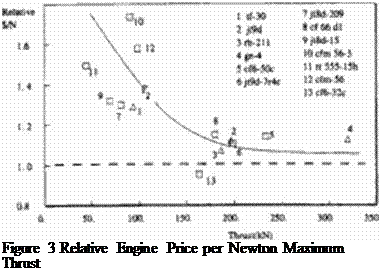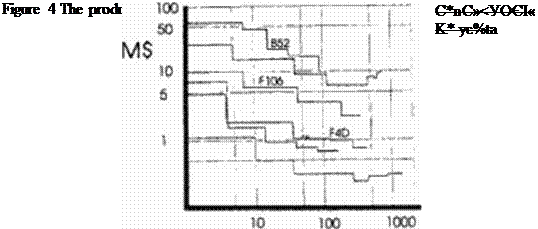Aircraft Cost – Manufacturer
The production cost of for each aircraft in a scries will greatly depend on the following considerations:
• Aircraft Size – Assuming that all aircraft arc designed with a comparable degree of sophistication. irrespective of size, then и is clear that the aircraft cost of dcsclopmcnt increases linearly with size. Even though increased research can decrease empty weight, if all designers have a common set of weight to economy tradeoffs they will all stop developing at a comparable degree of sophistication. Figure I shows relative inflation corrected airframe prices as a function of size. Except for very small aircraft a constant cost per pound can be assumed.
• Technology risk. As Mach number increases, more expensive materials must be u. sed and expensive systems make up a larger fraction of the empty weight which increases the airframe cost per unit weight. Figure 2 shows the relative cost per kilogram airframe as a function of maximum flight speed corrected for inflation. Thought the primary source of this data is military it can still be used for civil transports because the cost of avioncs and weapons systems was not included. In addition, the Concorde data point was predicted well, as well as the average for subsonic commercial jets.
• Production Size. Based on market rescurch the company has to decide on where we Пх its breakeven point. Reference (27) provides sales figures for some successful aircraft programs For big and medium sized passenger transports a breakeven number of 400 seems reasonable. To obtain the sale pnee per airframe we now use Wright’s 809r learning curve as described in reference [39] and (32) and a representative cod per unit weight and thrust for commercial aircraft. Figure 4 shows actual recorded learning curves.
Based on current pricing policies the follow ing equation can be used to predict the current (and) future price of aircraft.
|
C r 7 ( 800 D m. F. F. ) л. *° 322 of ac af 0 1 6c |
(2) |
|
C »30Z) Г t t max 1 |
(3) |
|
C * C n C ac af * e |
(4) |
 |
Where Fi is shown in Figure 3.
 |
Obviously it is not true that an aircraft can be sold for more money if it is heav ier or has bigger engines. The market price of the aircraft is solely a function range, payload and speed. Such definition of price would however not be useful at this time to tradeoff engineering features of a design. The assumption here is made, that aircraft manufacturers can only stay in business if they produce an aircraft with the same technical refinement as their competitors and charge a price that is closely iclaied to their production cost. So wc assume that aircraft are a commodity, which would not be true for an innovative design that would not have competitors.
 |
This simple relation should be corrected when non standard materials or technologies arc used. Usually the price per pound goes up more than proportional with the introduction of weight saving techniques This relation will have to he modeled if such weight saving techniques are considered. For composites every percent reduction in structural weight will at least cause a percent increase in the cost per pound











